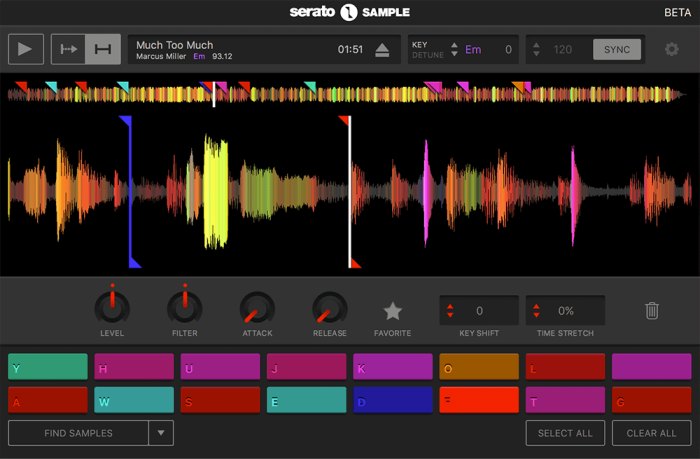

- #Keysboard sample chops how to
- #Keysboard sample chops generator
- #Keysboard sample chops code
- #Keysboard sample chops download
thanks for offering to help though, appreciate it! it’s just all the wiring and state management which will be a bit painful with the current what i haven’t mentioned yet is that besides doing web stuff professionally i also work at plug-in company where we use JUCE i’d like to avoid it for tahti though because of its licensing model, especially since iPlug2 is already in a pre-release stage. and yeah embedding a browser should also not be very difficult in itself. i already have a test project with the exact same DSP running natively because i wanted to see how the performance compared (turns out it’s ~10x better than via WebAssembly in the browser). IIRC, for example Safari added support for that this spring good timing!Īs for a plugin version, getting the DSP to work is not hard at all because SOUL can be compiled directly to C++.
#Keysboard sample chops code
the thing that actually makes this possible are modern Web Audio APIs, especially the AudioWorkletProcessor which allows for audio code to run in a separate thread. did a quick line count and it seems to be 26% SOUL, 61% TypeScript, 12% SCSS and 1% C++. Getting very technical there’s really nothing that i haven’t mentioned yet. Give me a shout if you’d be interested to chat more about this some time!
#Keysboard sample chops generator
I guess what I am imagining is you could use the SOUL JUCE project generator to create a JUCE app running your DSP, then use my module to integrate your existing UI (running in a WebView), so most of the work would be hooking up the communication between the two (in theory, lol). It’s pretty rough, but I think the basics work and it wouldn’t be too hard to make it more “production ready”. I’ve also created a simple synth to demonstrate it. I’ve created a JUCE module which allows you to pass structured messages between C++ and JS running in a WebView, and it can automatically synchronise plugin parameters between the two if you are using ValueTrees (right now this hooks into MobX on the UI, but it should be possible to adapt it to Redux I imagine, I just haven’t used Redux for years!). There’s a good channel on YT I follow called WDS (Web Development Simplified I think it’s called) - really clear explanations of concepts and techniques.īy the way regarding making this into a plug-in or mobile app… I’ve done some experimentation into creating JUCE plugins with web technology-based UIs (I’m from a web development background but have dabbled in some audio stuff, and find building UIs in C++ so painful compared to web, so I had to do something about it!). It’s stretching me a bit now as I find it hard to grasp exectly what’s going on with async stuff. Next step is to migrate the data again but this time to a proper database (Monogo/Mongoose). Migrated the data handling to JSON and fancied it up a bit with ChartJS and Bootstrap. Since then I’ve leared a lot more about client/server communication and brushed up my JS (I was more experience with Python) and turned the little project into a larger one by implementing it on a Flask server (all runs off one of my old Raspberry Pis).
#Keysboard sample chops download
Originally it was a simple cron job that generated a static image of the last 24 hours of download speeds test results (stored as CSV). Luckily for me I had a real world problem to solve and made a broadband speed test thing for my dad as he’s always having real trouble with quality of service (wireless broadband). Problem with me is I don’t learn very well from tutorials, I need a project. I do feel I’ve come on leaps and bounds recently as a few key concepts that baffled me for a long time fell into place. Save your new samples by clicking the x button to close the window.Haha, I know that feeling. Highlight all your samples and drag and drop them into the ‘new group’.Ĭlick Groups next to Zones (top left) which will take you to another window, your group window.Ĭhange the polyphony to ‘1’ this will cut the sample every time you press another key giving you the feel of a proper sampler. Your new group will be in the box on the left of the window. A new edit will open for you to drag and drop the samples you’ve chopped.Ĭlick ‘ok’ then go to ‘Group and create a new group. If this is to hard to get in time use the marque tool and manually chop where necessary. Play the sample and chop the parts you want using a tempo of your choice. You can assign a new key on your keyboard that will chop the sample at playhead.

Go to Logic (top left corner) hover over key edits and type in split. Once you’ve decided on the sample you want to use, drag and drop it into the arrangement window.
#Keysboard sample chops how to
In this video KC explains how to chop samples ready for use in Logic Pro EXS24 sampler. By KC Sounds - Comments Off on How To Chop Samples In EXS24


 0 kommentar(er)
0 kommentar(er)
